Content marketing has long been a pillar in B2B relations, and its importance is only growing.
During the height of the pandemic, when in-person selling and events were put on pause, content marketers were at the forefront of many B2B marketing efforts. In fact, 83% of businesses were able to boost brand awareness with their content strategy, plus 67% increased demand and lead generation (up 7 percentage points since last year). As a result, around 88% plan to maintain or increase their content marketing budgets in 2023.
However, throwing money into your digital content won’t necessarily make your marketing efforts more effective. To get the most bang for your buck, you need to develop and distribute valuable, relevant content that draws B2B customers down your sales funnel.
Lucky for you, we’ve put together a list of the top 20 B2B content marketing examples with explanations on why and how they work. But before we dive into that, it’s essential to cover the basics of B2B content for your digital marketing campaigns.
What Makes B2B Content Different?
Content marketing is often thought of and talked about in terms of B2C companies which target and speak directly to consumers. Even today, there are people in the B2B space who think of content as viral videos or social media posts ill-suited for selling enterprise-level software or services.
While a funny TikTok or snarky social media account might not be right for your B2B business, content marketing is much more than that. From blog posts and webinars to gated content like eBooks and white papers, each content format offers an opportunity to engage with your target audience or, more specifically, the real people buying your products or services. The ultimate goal is to connect with your B2B customers and provide them with content that directly addresses their interests while driving conversions and loyalty.
Goals of a B2B Content Marketing Strategy
Connecting with and engaging your B2B audience is critical to your business objectives, but it’s also a nebulous goal. To be successful, your content strategy needs to first define what success means by outlining specific achievement milestones along the way. We like to use the SMART process to ensure each goal is:
- Specific: Be precise about what you want to accomplish.
- Measurable: Define how you will quantify progress and success.
- Achievable: Make sure your goals are attainable and not far-fetched.
- Relevant: Align your goals with your business strategy.
- Time-based: Create a timeline based on how long it will take to achieve your goal.
Using these criteria, it’s easier to visualize the big-picture objectives of your business and outline steps to take you there. Depending on what your company aims to achieve, B2B content marketers may have a variety of goals, such as:
- Building B2B brand awareness through content creation.
- Attracting new leads and customers.
- Engaging prospects and customers with relevant content.
- Developing brand loyalty.
- Increasing organic traffic with SEO-driven content.
- Educating leads and customers with informative content.
- Driving conversions with strong calls to action.
While each of these goals has distinct metrics, results and best practices, the core content marketing strategy behind them acts as a multi-use tool, enabling you to achieve multiple objectives.

20 B2B Content Marketing Examples
Take a look at any successful B2B company and you’ll see that content marketing is an essential part of their overall marketing strategy. But that doesn’t mean you need to churn out mindless assets and articles. Instead, focus on producing valuable content that’s relevant to your readers and your business goals.
Whether it’s a product flier or a detailed research paper, your content ideas should speak to a target audience and address their unique challenges. Furthermore, your content should be geared toward specific B2B buyer personas and delivered at the right stage of the funnel.
When all of these elements fall into place, you get a cohesive content strategy that produces exceptional results. But take it from a writer: Coming up with B2B content can be difficult, especially when you’re staring at a blank page.
To help give you some inspiration, here are 20 of our favorite B2B content marketing examples:
1. Start a Business Blog
Neil Patel is a digital marketing and SEO guru whose blog offers tons of great content for all knowledge levels, from novice to expert. His conversational tone and aversion to complicated jargon keep each blog post engaging and inviting while still being detailed and informative.

Not only does Neil’s blog offer great tips and best practices, it also acts as an excellent example of a business blog that grabs attention and ranks high in search results. I frequently read his posts to discover new tactics and brush up on marketing strategies.
2. Become a Thought Leader
Deloitte is known internationally for its detailed industry analysis reports and insights from leading experts. In other words, the company is widely held as a thought leader — and it’s clear to see why.
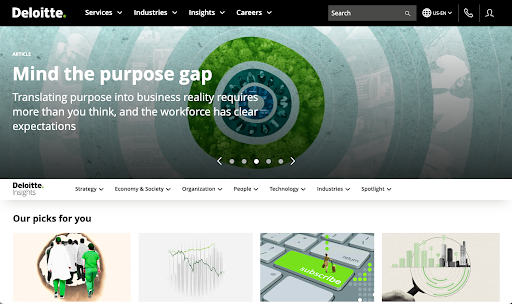
On Deloitte’s Insights page, you can find a wealth of articles on all manner of subjects. There’s even a „Watch & listen“ section with videos and podcasts for engaging audiences with audio-visual content.
Perhaps most popular, however, are the detailed analyses and reports, like the 2022 Global Market Trends. These resources offer visually engaging insights and valuable information on a wide variety of industries.
3. Add Some Flare With an Infographic
Infographics are an excellent way to grab attention and engage your audience with vibrant visuals while delivering valuable information.
Imperva, a leader in the cybersecurity space, put out this incredible example with eye-catching animated elements that present complicated information in a way that’s easy to understand.
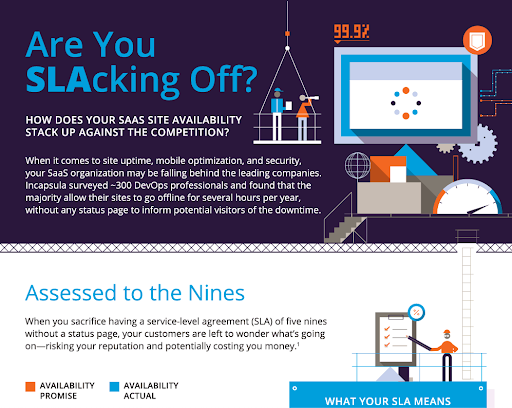
The simplified art style and consistent color palette are pleasing to the eye, acting as a visual aid in understanding the data presented.
4. Engage Your Viewers With Videos
Video content is another great way to engage your audience through visuals. Often, these come in short-form snippets of easily digestible knowledge. While it might be tempting to cram as much detail as possible into a 60-second script, your audience will likely not be able to process the rapid-fire information.
Slack, one of the leading messaging platforms for B2B businesses, exemplifies the less-is-more approach perfectly in its Understanding Slack series on YouTube.
These videos are all around 1 minute in length, only covering what’s essential. They get to the point quickly with clear messaging and sleek visuals that showcase how easy it is to use the software.
5. Interview an Industry Expert
Interviews with industry leaders can offer your audience a glimpse into the minds of experts while bolstering your brand as an authority in your space.
Forbes has a great video series interviewing CMOs from major corporations, such as Cisco, Samsung, Wells Fargo, Deloitte and more. These two- to three-minute videos offer viewers valuable insights into industry trends and the opinions and experiences of leading experts.
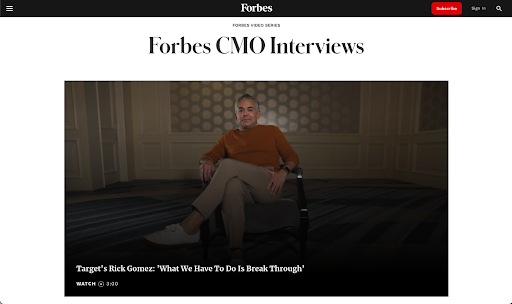
But you don’t have to seek outside voices for your interviews. Sit down with experts from your own company to discuss the topics they see as important.
6. Host In-Depth Discussions in a Webinar
Since the pandemic, the popularity of webinars has skyrocketed. These long-form videos offer B2B companies a great way to gather people virtually for panelist discussions, training sessions, product demos and much more.
Webinars can be pre-recorded or live, but the latter option offers more opportunities for audience interactions. For instance, Semrush had a webinar series in which viewers could nominate their websites for a live audit from SEO experts.
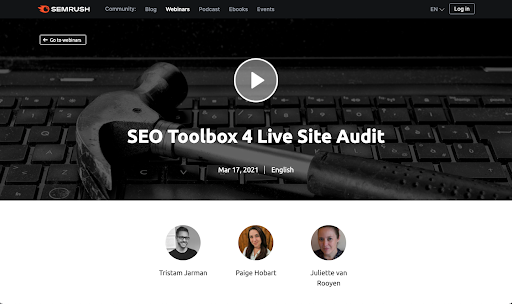
By inviting your audience to participate in your webinars, either through a demonstration of your services or even just live polls, you make them feel seen and valued. Not only does this boost engagement, but it also helps you increase loyalty and, ultimately, conversions.
7. Start a Podcast to Dive Deeper into Insights
While the idea of starting a podcast has become a bit of a meme as of late, the numbers show that listenership is growing. In fact, by 2023, Apple and Spotify are expected to reach over 66 million monthly podcast listeners in the U.S. alone.
If you’re looking for inspiration, look no further than B2B Growth from Sweet Fish Media. These short podcasts offer listeners daily insights into topics like B2B marketing strategies, content marketing, social media and more. There’s even a rather meta episode on the power of podcasting to drive engagement.
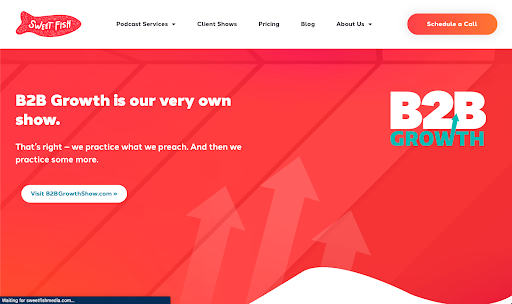
8. Boost Brand Awareness With Social Media Posts
Many B2B marketers think of social media as a place for marketing exclusively to teenagers and everyday consumers. However, this discounts the countless B2B decision-makers who use social media in both their work and personal lives.
While Twitter might be crashing, platforms like LinkedIn and Instagram are still great places to bolster your B2B brand. In this humorous post for the U.S. Open, IBM teamed up with content creators to promote its new app to track and analyze tennis matches.
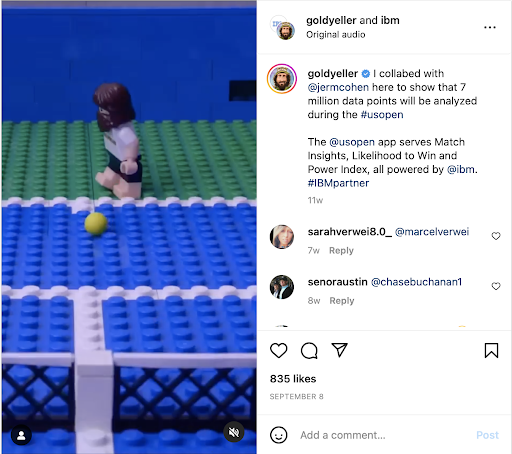
9. Target Your Efforts on LinkedIn
LinkedIn offers an invaluable platform for B2B content marketers, with millions of senior-level decision-makers using it every day. Whereas other social media sites, like Facebook, Instagram and Twitter can get crowded with irrelevant content, LinkedIn was made exclusively for professionals — especially in the B2B space.
For the marketing software giant HubSpot, leveraging LinkedIn is a no-brainer. Not only does the company promote text ads to get in front of users, but it also uses customer data to craft better content that drives conversions and growth.
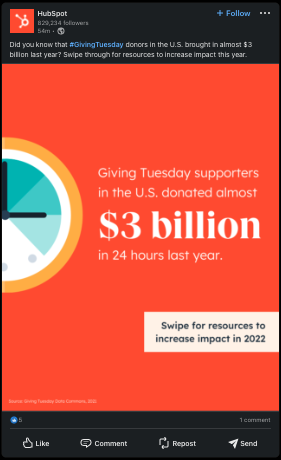
10. Use Slides From Your Pitch Decks
In many ways, B2B buyers are just like the average consumer; they want short, punchy content that gets right to the point. Using slides from your original pitch presentation can be an easy and efficient way to showcase value in a quick and simple way.
For instance, Square, the mobile payment solution company, released its original pitch deck which distills key value propositions into simple copy and visuals.
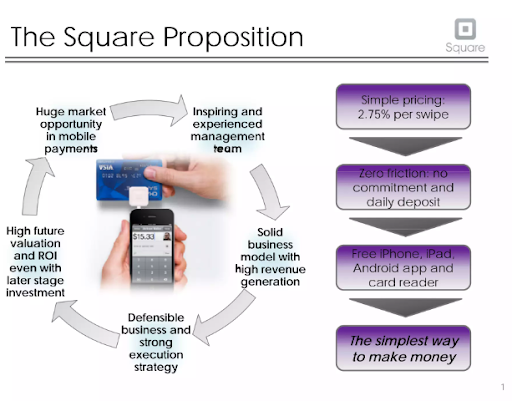
While the graphics might need an update, slide 17 offers a great starting point for a killer infographic.
11. Update Your Audience With a Press Release
Whether you’re sharing general company news or an exciting announcement, press releases can help your B2B business get the word out to your target audience and maybe even gain some media coverage.
In the case of Zoom, the company was facing concerns about security following its meteoric rise during the pandemic. As part of a larger response, Zoom published a press release announcing that it had acquired Keybase, a secure file-sharing and messaging platform. In this release, the company also outlined its current and next steps they were taking to improve security.
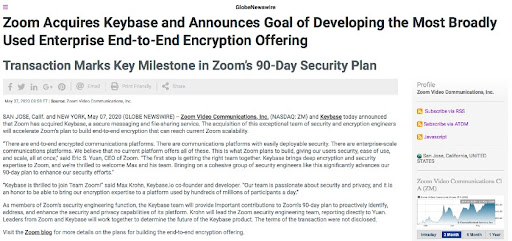
12. Generate Buzz With a Glowing Testimonial
From word of mouth to online reviews, businesses rely on their customers to vouch for them. I know I hardly buy anything without reading the reviews, and B2B buyers feel the same.
Testimonial content gives your audience deeper insights into how your current customers use and feel about your products or services. Shopify offers an excellent example in its Success Stories. These customer interviews provide detailed descriptions of how they use the platform to launch and maintain their businesses. While Success Stories showcase the platform’s strengths, it’s also valuable to add reviews to Shopify store. This allows customers to share their experiences, which can build trust and encourage others to buy.
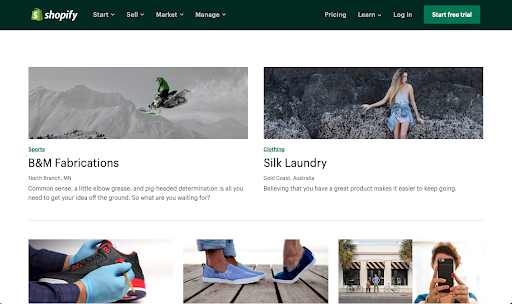
13. Unveil a New Product Catalog
While you might think of product catalogs as junk you get in the mail, they can be an invaluable tool for B2B customers researching and deciding on a purchase. And in the age of eCommerce, having a digital catalog is critical for customers to find the items they need.
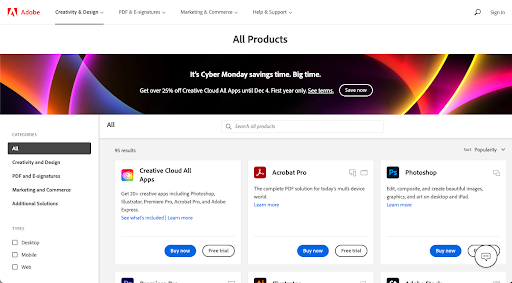
Adobe did an excellent job in designing its online product catalog. Not only does the site look appealing, but it’s also easy to use with search and sort functionality by product categories and types.
14. Showcase Your Strengths in a Case Study
Similar to a testimonial, case studies are a way for your business to show off its strengths to potential customers. However, instead of interviews emphasizing the „why“ behind a customer’s decision, case studies follow up on how your company has helped them.
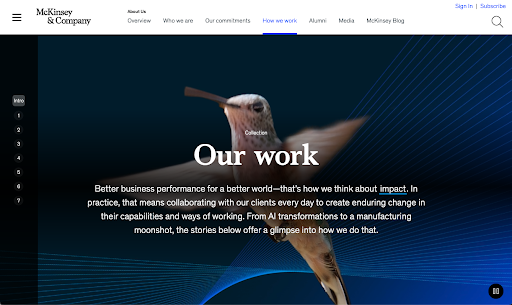
The international consultancy company, McKinsey, has published multiple engaging case studies that dive into the direct impacts and results that customers experience from its services. While yours don’t have to be as extensive as McKinseys, they should follow the basic framework of challenge, solution, outcome.
15. Get Technical in a Research Paper
Research papers provide your customers with highly detailed reports on all sorts of subjects, from general market trends to niche areas of expertise. Due to the time and effort it takes to produce a research paper, this content is typically gated, allowing marketers to gather more information on leads.

The management consulting company Gartner is renowned for its Special Reports, which cover a wide range of industries. These reports provide a wealth of information to direct customers, but they also generate brand awareness when other B2B content creators cite Gartner as a source.
16. Lead Prospects Down the Funnel With an eBook
eBooks offer content marketers excellent opportunities to engage leads who are in the middle of the sales funnel. Informative copy combines with vibrant visuals to assist readers in their research and consideration stage.
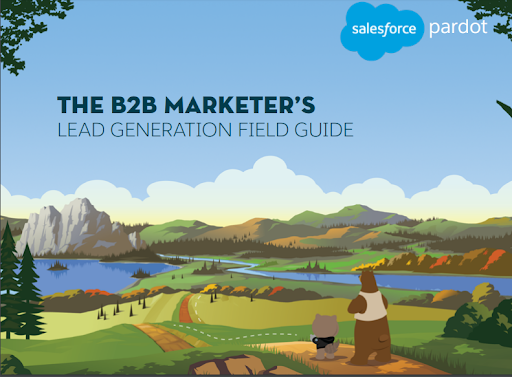
Pardot, and parent company Salesforce, created this stunning example complete with cute illustrated characters. These visual elements help draw the reader into the content while sliding further down the sales funnel.
17. Educate Your Audience Using White Papers
You can think of a white paper as something that’s halfway between an eBook and a research paper. While they aren’t as visual, white papers offer in-depth content to customers and prospects looking to learn more about your company. These text-heavy documents boost your authority while acting as powerful lead magnets.
Google Cloud’s AI Adoption Framework is a perfect example of a white paper’s visual simplicity and complicated subject matter. It’s information-dense and what few visuals there are stick to Google’s primary color palette.
18. Answer Questions on an FAQ Page
A frequently asked questions (FAQ) page is a commonly overlooked aspect of content marketing. These important repositories of information provide your customers with an easy place to find answers to their common questions.
Microsoft goes above and beyond with its FAQ pages which are tailored to different types of users. Regular consumers can answer their questions using the Microsoft 365 FAQ page, while business users can narrow their search with the Microsoft 365 for business FAQ.
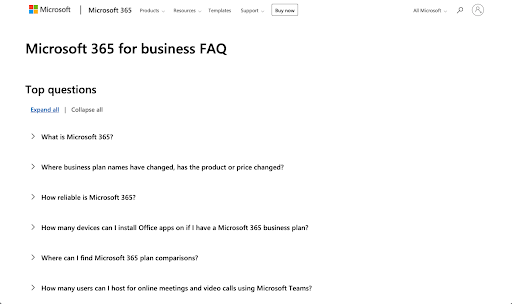
19. Keep in Touch With Email Marketing
Email’s ubiquitous use has made it one of the most effective ways to get in touch with B2B audiences. Whether you’re nurturing leads, welcoming a new user or sending promotional information, email marketing provides a direct line of communication between you and a buyer.
What better place to look for an example than MailChimp? When the company launched its Pro features, it also initiated an accompanying email campaign. While there’s minimal text, this email design allowed the image to stand out and grab readers‘ attention.
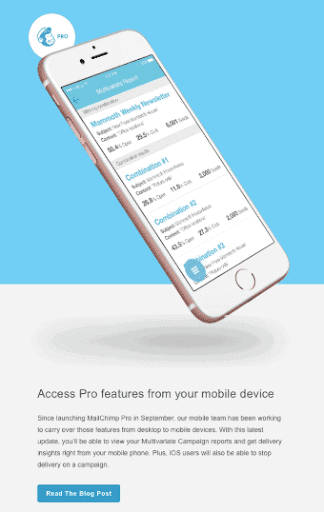
20. Stay Consistent With a Newsletter
Newsletters are an important part of email marketing campaigns, allowing businesses to maintain consistent communication with customers on a weekly or monthly basis. Done right, these emails can help you distribute valuable content, drive traffic to your website and generate more conversions.
One of our favorite newsletters has to be from Moz, the SEO software company.

Interestingly, Moz chooses to highlight relevant external articles in its newsletter. While it might seem counterintuitive to push outside content, it can help to build trust with your audience while still increasing engagement.
How to Get Started With B2B Content Marketing
Wow, that was a lot. After all those examples, it’s easy to feel overwhelmed about B2B content marketing, but don’t worry! Adding just a few of these content ideas to your strategy can make a big difference, enabling your B2B business to drive better engagement and generate new leads.
Whether you’re just starting out or you’re looking to improve your game, we’ve got the techniques and information you need for a successful content strategy in our newsletter, The Content Marketer.





